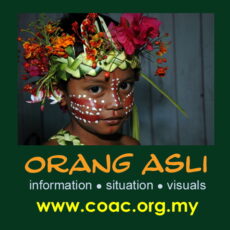The life-risking stretch of road from Kampung Bawik to Pos Tohoi in the Kuala Betis regroupment scheme described in the article below (“In the interiors, abandoned by all”), is now passable to most sturdy vehicles. In fact, when we visited the area last week, some likened the road to a highway in the forest!
Indeed, it did seem so as our 4WD breezed through the 22-km journey to the Perias River, which is still a major obstacle preventing access to the interior Temiar areas.
The dry weather the past few days gave the loggers the window to repair the small log-bridges and put their bulldozers to work. They are not doing this as part of their service to the nation, though.
One of the bigger loggers here is reported to be incurring rental fees of RM3,000 per day for the heavy machinery that is stuck on the other side of the Perias River.
Logger, with Orang Asli daily-waged workers, assessing how to retrieve 15-metre iron base of the bridge over the Perias River. His boss is incurring RM3,000.00 per day in rental of heavy equipment stuck in the forests on the other side of the river.
Many villagers on the other side of the river are also cut off. The roads beyond there, especially to Pos Gob and towards Pos Slim are still bad, and impassable to 4WD vehicles. Many Temiars, however, continue to make the day-long journey out on motorbikes or on foot, to get food and other aid.
The bamboo rakit (raft) is still effective in hauling people, goods and motorbikes across the swift-flowing Perias River.
The local Flood Relief Action Committee based at Kampung Parik have been trying to ensure that those coming from the interiors get what they came for. However without a vehicle of their own, the quantity and frequency of their aid delivery trips is not yet optimum.
The villagers in Pos Humid and Pos Balar have also succeeded in creating access further into the Betis hinterland. Working for two weeks with just garden changkuls (hoes) and their own labour, they have been able make the roads passable to 4WD vehicles right up to Kampung Tapai. A food collection point is being established there. Villagers from Pos Balar will still need to walk about 3 hours on foot to reach it.
For the interior settlements, especially the small ones still not reached by the authorities or the NGOs, we are doing two days of helicopter runs on 25-26 January. After this, we hope the roads will be passable for off-road vehicles to these settlements. The heli drops are limited in what they can supply (maximum 500kg per trip) and the cost is much more than what land transport would incur.
CN-COAC | 24 January 2015
Tohoi, which was one of the severely affected villages, is now reachable by road.
The villagers from Kampung Gawin in Pos Gob have chosen this site as their temporary base.
The Gawin people whiling their time away on the banks of the Perias River.
The rafts carry people ….
… goods …
… and motorbikes. Mainly.
The temporary shelter used by the villagers from Kampung Jader in Pos Simpor.
Watching the activities in the river.
Basic facilities for the night. Utensils, stove, groundsheets and blankets have since been supplied.
Quenching everyone’s thirst with the abundant river water. Carrot from DAP putting the Jerrycan water filter donated by UFilta Sdn Bhd to good use.
The school at Tohoi is still not ready for classes.
The environment then becomes their schoolhouse.
The Local Action Committee discussing the logistics of moving the donated food and other items.
Dr. Kumar, the PSM Member of Parliament for Sungai Siput delivered some much-needed supplies of blankets.And no, it is not spicy chiken in those boxes.
About 30 tonnes of food aid came in to the center last week. A large group of Temiar volunteers sort them into family packs before distributing them. Most of it will be distributed this weekend (by two days of heli-drops and also by land).

